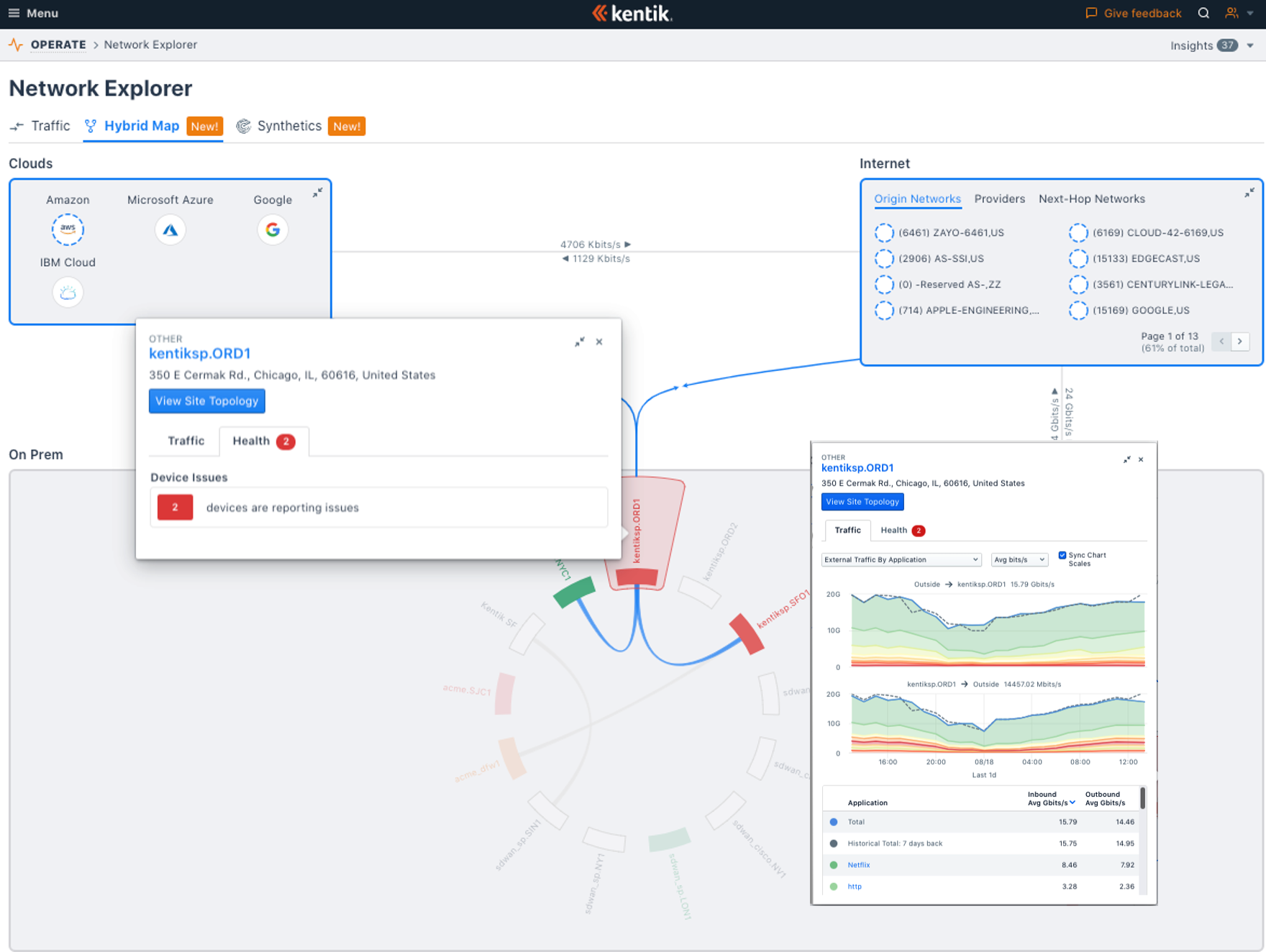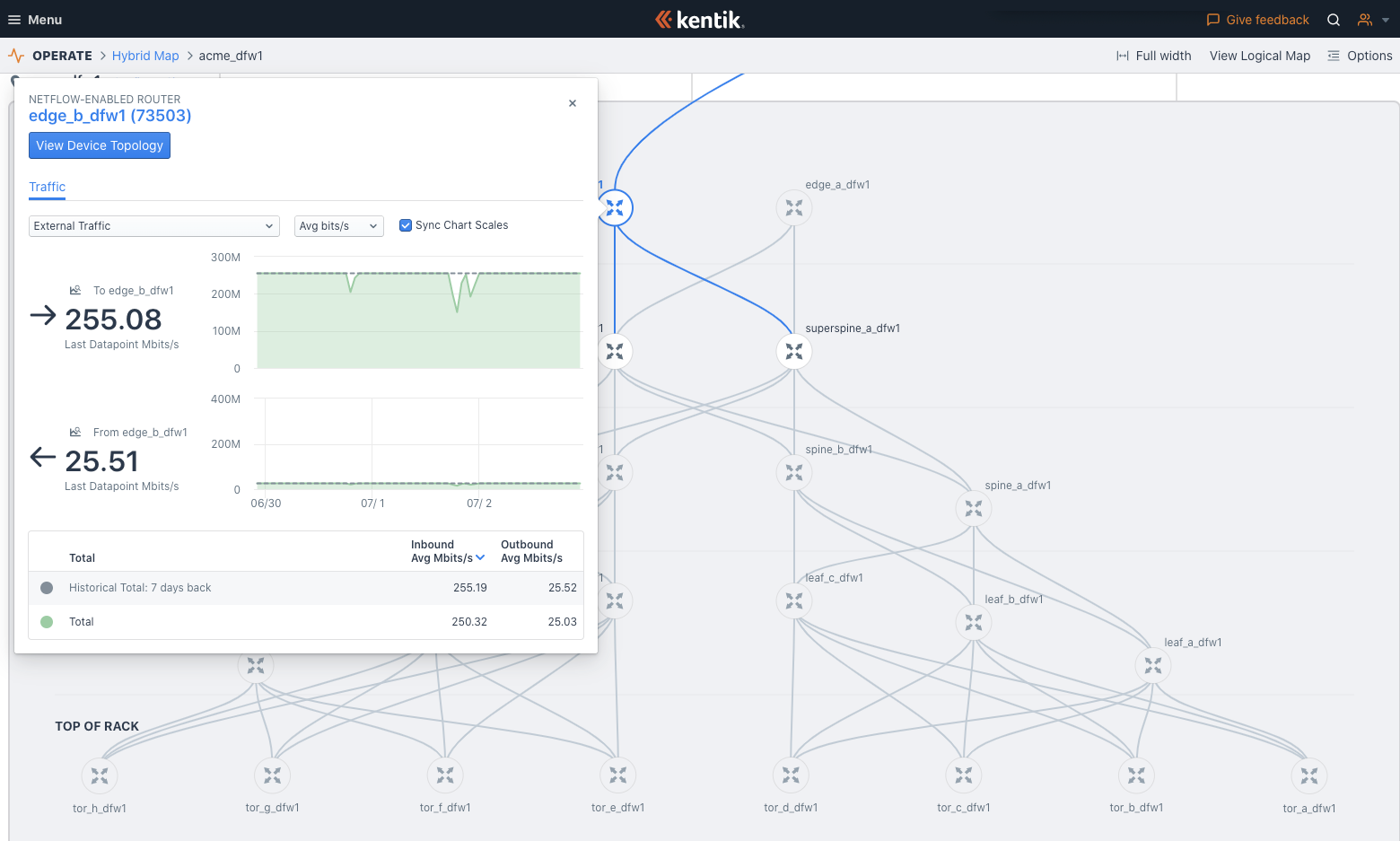Kentik Bridges the Intelligence Gap for Hybrid Cloud Networks

Summary
Kentik’s Hybrid Map provides the industry’s first solution to visualize and manage interactions across public/private clouds, on-prem networks, SaaS apps, and other critical workloads as a means of delivering compelling, actionable intelligence. Product expert Dan Rohan has an overview.
As Kentik’s product manager for hybrid cloud, I am always talking to infrastructure and network teams around the world to understand a day-in-their-life. This provides me with an invaluable understanding of the challenges, goals, and priorities that they face today, and also a vision into their future network monitoring needs. Listening to our customers, partners and other infrastructure and network teams delivers critical feedback and excellent insight into their struggles, which helps drive Kentik’s product direction and future strategy to remove these challenges.
One common frustration I heard was the difficulty in managing their hybrid cloud environments. IT resources, including those managed by Kubernetes and other container scheduling platforms, can be provisioned or de-provisioned in seconds creating surprising shifts in application delivery traffic. Undermining this scalability were network overlays that enable connectivity while obscuring details necessary for effective troubleshooting.
Infrastructure and network teams can no longer rely on internal documentation or legacy tools to help them understand how their applications are delivered and what health or performance issues are getting in their way. They have been left with gaping holes in visibility, preventing them from holistically understanding topology state, traffic flows, network performance and device health status. Until now.
This is why, today, Kentik is introducing Kentik’s Hybrid Map, which lets these teams view the entirety of their network infrastructures, enabling them to dive deep, assess quickly, solve problems and gain insights immediately. You can now visualize and manage interactions within and between on-prem infrastructure, cloud infrastructure from Amazon AWS, Google Cloud, IBM Cloud and Microsoft Azure, as well as internet platforms and services — all in a single, unified view.

Go inside your cloud infrastructure to see how applications are communicating inside the cloud, to the internet, and your on-prem network.
The Growth of Hybrid Cloud
We at Kentik know that hybrid cloud — the use of multiple IT infrastructures, both on-prem and in the cloud, to deliver computing services across an organization — has many benefits for infrastructure and networking teams and hybrid cloud usage is only going to grow as a result of the 2020 pandemic and the move to remote “everything.”
Just in 2018, eight out of 10 companies increased cloud-based workloads. And due to the pandemic, according to the 2020 Flexera State of the Cloud Report, 59% of respondents who answered a question about COVID-19 expect cloud use to exceed plans. As businesses combine the governance advantages of on-prem systems with the flexibility, “always-on” availability and cost advantages of the cloud, this ongoing “cloud migration” allows IT managers to scale their network environments to support specific workloads or applications with the best customer experience in an extremely secure way.
In this new hybrid cloud world, infrastructure is located wherever the business needs it, meaning that data can be located anywhere, too. In Gartner’s Market Guide for Network Performance Monitoring and Diagnostics, analysts predict that, by 2024, 50% of network operations teams will be required to re-architect their network monitoring stacks due to the impact of hybrid networking — a significant increase from 20% in 2019. This makes the network an even more critical resource.
As organizations like yours adopt hybrid cloud environments, your network teams are under increased pressure to deliver the visibility required to optimize business operations. In The State of Cloud Monitoring report, 99% of those surveyed identified a direct link between visibility and business value and listed “increasing cloud visibility for greater operational control” as a top priority.
At Kentik, we can take this huge challenge and flip it on its head, making it an asset for your organization and removing the complexity your infrastructure and networking teams experience. With Hybrid Map, you now have the opportunity to see things you could never see before and use them to your advantage. You can close operational gaps, getting actionable intelligence about who is using the network and what they’re using it for. Visibility and insights are hard to come by when the location of resources fluctuates between on-prem and public/private clouds. Not anymore.
The Challenges of Managing Hybrid Networks
Hybrid networks are complex by nature. Using traditional network management tools, network professionals charged with tracking down performance and availability problems can struggle to piece the network together in time to fix critical issues. It’s difficult to discover which devices and interfaces make up a data path. Correlating the traffic, health, and performance of these elements consumes valuable time that could instead be spent understanding and fixing problems.
What we found was that no one network performance monitoring and diagnostics (NPMD) vendor offered a single, comprehensive map that contributes to intelligently managing your hybrid network. According to a survey of IT professionals in the report The State of Public Cloud Monitoring, 35% of respondents use up to five monitoring tools to keep tabs on hybrid cloud and multi-cloud environments. Each tool has a specific purpose and thus tells only an isolated portion of the story. There are backbone network maps, capacity maps between sites and devices, cloud visualization maps for a specific cloud, and edge maps for edge networks. But no one consolidated, fully-integrated map for hybrid, multi-cloud networks.
Automation, orchestration, and software-defined networking further complicate matters by constantly shifting where applications are located and redefining how they connect to one another. Without tooling built to comprehend this new reality, your network — and the team that runs it — is at a disadvantage.
Compounding the challenge are business pressures for you to optimize operations across multiple infrastructures, especially when the business is either migrating from data centers to clouds or is acquiring new infrastructure through mergers and acquisitions.
The Kentik Solution - Solving the Visibility and Monitoring Gap
Using all these great insights, we now introduce Kentik’s Hybrid Map — providing the industry’s first solution to visualize and manage interactions across public/private clouds, on-prem networks, SaaS apps, and other critical workloads — to deliver compelling, actionable intelligence. Kentik’s platform helps you automatically discover traffic anomalies, determine root causes, and launch automation to mitigate issues.

Drill into data center devices to understand how your applications flow through your data center fabric.
Available now, Kentik’s Hybrid Map has the following key elements to empower network and infrastructure teams:
-
A single view for network maps: To visualize every aspect of your network, keep track of changes to your infrastructure, and get a view of historical data in context.
-
Map drill-downs: To gain insight into physical or cloud-based devices. Also, to investigate problematic network utilization by discovering which application, on which node, in which interface, IP, region, zone, or subnet is the culprit.
-
Network component and traffic detail views: To observe real-time traffic flows or look at historical data to see how changes in the environment have impacted application delivery or customer experience.
-
Advanced traffic analytics, health and performance data: To get instant answers to common network questions.
In short, Hybrid Maps are everything you love about Kentik… now with added visibility for your hybrid cloud network. To try these features in your own network, start a free trial, or request a personalized demo from the Kentik team.



